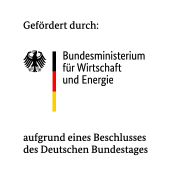Device for volume flow measurement during high convective heat treatment
Within this project we succeeded in developing continuously working volumetric flow measuring devices for convective heat treatment plants. The volume flow was determined by means of volume flow measuring devices (measuring ring, measuring cross) installed in the inlet nozzle of the fan. For the measuring devices, the influences of the measuring position, the operation of the fan (Liefer number φ, Re-number), the limitation of the intake range of the fan and the fan diameter should be known.
First, the basic flow profiles in the inlet nozzle were determined using a laser Doppler anemometer (LDA). The knowledge of the flow profiles enables a targeted positioning of the measuring positions for the volumetric flow measuring device to be developed. The results show that in certain measuring positions, volume flow measurement can be carried out independently of fan operation.
The knowledge of the flow profile was mainly used for the construction of the measuring cross. The measuring positions of the measuring cross were specifically inserted into the positions in the inlet nozzle recorded by means of the analysis of the flow profiles. The results confirm the knowledge. The volume flow measured by the measuring cross is independent of the operation of the fan. For the measuring ring there is a calibration coefficient dependent on the number of deliveries. The dependency is described with a linear equation.
The next step was to examine the influences of different limitations of the fan intake area on the volumetric flow measuring devices. It was observed that with an asymmetrical limitation of the fan a volume flow measurement is only possible by means of the measuring ring, but an additional correction is necessary. In the case of symmetrical limitations, volume flow measurement is possible using both measuring devices without additional corrections. The measuring devices function with different fan diameters without additional corrections.
At the end, the operating tests were carried out in a real plant environment using the measuring cross. The measurement results agree with a reference measurement. The goal of the research project was achieved.

This research project was applied for by the Forschungsgemeinschaft Industrieofenbau e.V. via the Forschungskuratorium Maschinenbau e.V. and financially supported by the Bundesministerium für Wirtschaft via the Arbeitsgemeinschaft industrieller Forschungsvereinigungen e.V., AiF-Nr. 16314 N.
